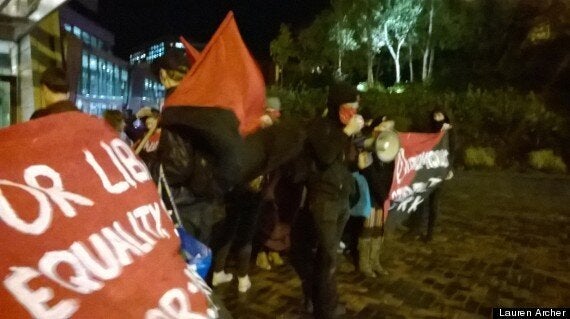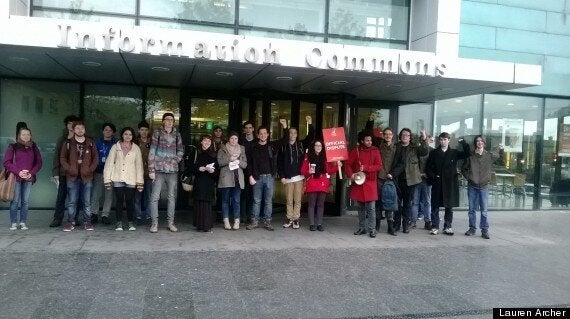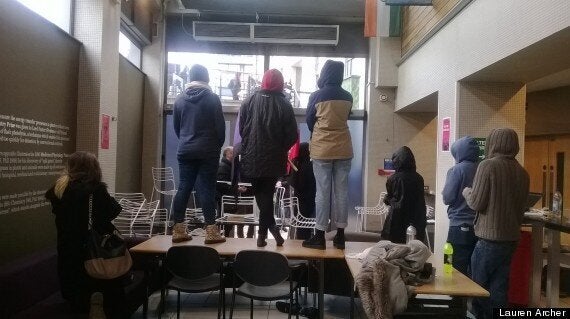It was 6am when the lights came on and Rage Against the Machine started playing through the speakers in the University of Sheffield's Richard Roberts lecture hall.
About 50 students from across Sheffield, including activists from the Autonomous Students Network, the Living Wage Campaign, the Revolutionary Socialists Society and others occupied the building at 7pm on Wednesday October 30, the night before the planned staff strikes.
The Occupation was held in solidarity with striking staff from Unison, Unite and the University and College Union (UCU), with the intention of preventing the university from operating as normal on strike day.
Eventually the activists shut down the entire Richard Roberts building, meaning that no planned lectures ran, even if staff attempted to cross picket lines.
University staff were striking as a result of a real terms pay cut of 13% since 2008, and the offer of a 1% pay increase this year, still below the rate of inflation.
Students originally rallied outside the SU at 6pm, giving short speeches in support of the striking staff, chanting against austerity measures and, specifically, against the pay rise of University vice chancellor Keith Burnett.

In 2012 Burnett received a 6% pay increase, bringing his total salary to £311,000, while many university staff still do not earn a living wage.
They then walked through the streets, chanting and singing, before moving into the Richard Roberts building and claiming it.
A statement from the Sheffield Revolutionary Socialists Society said: "We fully support the struggle of lecturers and uni staff for better wages, and extend solidarity to Sussex students also in occupation. We call on all students against marketisation, fees and wage cuts and for a fairer society to join the occupation!"
In the same spirit, a statement from the Autonomous Students Network said: "Our plan was and remains to support striking staff members at the university, prevent strike breaking and show other students that we can unite and support workers who face attacks from the same management that made the decision to implement £9,000 fees whilst making cuts to academic funding."
The occupation site was turned into a 'safe space', with a zero tolerance policy to harassment, gender-neutral toilets and the formation of a 'women's militia', who stayed together for the duration of the occupation in their own bloc. In light of this, the occupying students elected to ban Socialist Workers Party (SWP) members involved in the 'rape crisis' from the premises.
The 'crisis' refers to an era that split the SWP when many (now former) party members felt that an accusation of rape was not dealt with correctly.

That decision was later applauded on Twitter by columnist and author Owen Jones and comedian Mark Steel, who collectively spearhead the People's Assembly Against Austerity, a broad left-wing movement aiming to rally people against cuts and privatisation in the public sector.
Activists claimed the Richard Roberts foyer for the duration of the occupation, putting up banners and placards in the windows and postering the inside walls. Banner slogans included: "Students! The same people cutting wages are privatising your loans. Don't cross picket lines," courtesy of the Autonomous Students Network (ASN), an anarchist student group.
The occupiers also taped over camera lenses to avoid what one ASN activist termed "victimisation by the university management".
Security staff remained on premises throughout the occupation, complying with activists and offering to open the main auditorium so that the students didn't spend the night in the foyer. In return, security staff were offered cups of tea and biscuits.
Groups convened for 'caucuses': meetings with a political purpose, to discuss tactics for strike day. Eventually it was decided that the ASN activists would continue to occupy the lecture hall to disrupt strike-breaking lecturers, while other students would support striking staff on picket lines.
The night moved quickly, with activists taking advantage of the projector in the auditorium to play revolutionary songs. Some set up sleeping bags and hammocks, while others sat up through the night, talking and planning for the day ahead.

At around 5am the next morning a small group of students donned black hoodies and bandanas, left the occupation and attempted to block off the Arts Tower, a major lecture hall on campus. They moved bins into the stairwells of the building, attempting to blockade entrances to lecture theatres.
Security staff had removed the bins by the time picket lines formed at 7:30am.
At this point, socialist activists joined striking staff on picket lines, moving through the city in a 'roaming picket' to lend support to every departmental picket line they found. They were joined by more students and stood outside picket lines leafleting and urging students not to attend lectures. At some sites they formed static pickets, physically attempting to stop people attending their lectures. They were quickly moved on by security guards.
Sheffield ASN kept hold of the building, with some members standing outside to engage with students, encouraging them to boycott lecturers and support the strike.
By the time the roaming picket, comprised of the Living Wage Campaign, the Revolutionary Socialists Society, Socialist Students and independent activists, got to the main strike rally at 11am, security had tightened on the occupation site.
Security staff stood at the door, physically blocking it and refusing students re-entry. When activists attempted to duck under their arms or push past them they did not react, but informed them that anyone in the building without permission was being treated as a "trespasser".
A security guard had been walking behind the roaming picket for most of the day, wearing a body cam: a small video camera attached to his uniform. He had no comment regarding his reasons for following the students.
When asked about the camera, he replied: "I have been asked to video every student attending this protest."
The activists informally pledged that the occupation would continue in a peaceful and non-violent manner, with no intention of damage to people or property. There are currently no reports of any damage to university buildings.
Students from Sussex University and the School of Oriental and African Studies also occupied their university buildings, with Sussex activists Skypeing Sheffield during the night, pledging solidarity and wishing them 'good luck' with their protest.
The 'shocupation', the term for a short and sudden taking of a building, ended at 2pm, when activists began to clear the building and move furniture back from the barricade they had formed near the door. They left through a side door they had discovered, rather than the front doors manned by security.
An anonymous anarchist told me: "We like to leave on our own terms. We pick our own route and our own time."
A new group was formed inside the occupation: Student Staff Solidarity Sheffield. Members of the group, which includes anarchists, socialists, and independent activists, have launched a blog documenting their action.
Four more days of action have been mandated by the unions, which Student Staff Solidarity Sheffield have pledged to support.